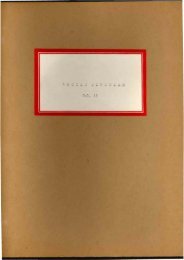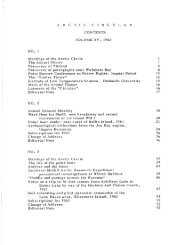Volume 4, 1951 - The Arctic Circle - Home
Volume 4, 1951 - The Arctic Circle - Home
Volume 4, 1951 - The Arctic Circle - Home
Create successful ePaper yourself
Turn your PDF publications into a flip-book with our unique Google optimized e-Paper software.
of committees made up of the former local councils in the<br />
sixteen main constituencies. Thanks to this careful preparation,<br />
the elections took place without serious mistakes. ln<br />
two constituencies only was it necessary to repeat the<br />
elections: in the most northerly (Upernavik) because ice<br />
conditions prevented distribution of some of the lists of<br />
candidates in time, and in the southernmost (Nanortalik)<br />
because an epidemic of measles, the first in Greenland,<br />
kept nearly everyone in bed on election day.<br />
<strong>The</strong> nomination system caused most difficulty, since<br />
it was something new in Greenland elections. ln order to<br />
be nominated, a candidate needed from five to ten sponsors.<br />
ln many places election meetings were held by some candidates,<br />
and in a few cases there was evidence of a real election<br />
campaign, as for example in the capital Godthaab, where the<br />
former veteran member of the Provincial Council was defeated<br />
by a more progressive candidate after an active campaign.<br />
<strong>The</strong>re are as yet no real political parties in Greenland, but<br />
in several places fishermen, hunters, or groups of workers<br />
and government employees campaigned for their favourites.<br />
<strong>The</strong> rules governing nominations were designed to encourage<br />
the formation of political parties, and it is believed that<br />
later elections will find them more active.<br />
About 8,750 persons in V/est Greenland were Clualified<br />
to vote, and about 6,400 of them actually went to the polIs.<br />
<strong>The</strong>re they filled in two ballots (one for the Provincial<br />
Council and one for the District Council) each with the<br />
name of a candidate and a "substitute". On an average 73<br />
per cent of the electorate voted, the highest turn-out being<br />
89.5 per cent and the lowest about 55 per cent.<br />
<strong>The</strong> elections were the first at which women had been<br />
permitted to vote. Many women used their votes and several<br />
were nominated. None was elected to the Provincial Council<br />
and only one to a District Council. A few Danes were elected<br />
to District Councils, but none to the Provincial Council<br />
although several stood for election. <strong>The</strong> new Provincial<br />
Council, which met from 25 September to 23 October <strong>1951</strong><br />
under the Chairmanship of the Governor of Greenland was made<br />
up as follows:












